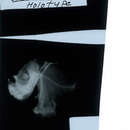en
names in breadcrumbs


View data on Catalog of Fishes here.
Known only from a single specimen, 33 mm SL. Dorsal-fin rays 14; anal-fin rays 15; pectoral-fin rays 13; total gill rakers 19; vertebrae 33. Body very broad, narrowing abruptly to short narrow caudal peduncle; body depth 1.3 times into SL; post-temporal spine length more than one-half diameter of orbit, extends to origin of dorsal spine, very spinose dorsally and laterally; frontal ridges almost vertical, spinose; postabdominal spines well developed; abdominal keel scales extend well beyond ventral body margin; these scales sharply triangulate, coming to a single or double point ventrally; subequal scales smooth; first supraabdominal photophore raised considerably above other two; subequal photophores raised well above anals; first supra-anal photophore noticeably lower than second which is lower than third; anal photophores in two distinct groups; jaws large; teeth small, several recurved ones in upper jaw; vomerine teeth well developed; gill rakers medium, spinose; in preservative pigment somewhat darker dorsally; pigment striations present on trunk.
Abdominal keel scales triangulate, with one or two large ventral spines; post-temporal spine long, heavily spinose dorsally and laterally; first supra-anal photophore markedly lower than third; anal photophores 6 to 7. Post-temporal spine with a single, redueced but distinct basal spine; anal-subcaudal distance greater than one-half of the length of the subcauclal group ; anal photophore number 6 to 9. Post-temporal spine complex, bearing one or two basal supplementary spines; dorso-lateral edge of fused, post-temporal-supracleithrum serrate; abdominal keel scales with spiny ventral surfaces; supra-anal photophore group usually not distinctly separated anal group.
Known only from a single capture near the Marshall Islands.
Baird RC. 1971. The Systematics, Distribution, and Zoogeography of the Marine Hatchetfishes (family Sternoptychidae). Bulletin of the Museum of Comparative Zooology 142(1):1–128.
Baird RC. 1971. The Systematics, Distribution, and Zoogeography of the Marine Hatchetfishes (family Sternoptychidae). Bulletin of the Museum of Comparative Zooology 142(1):1–128.
Known only from a 33-mm SL specimen.
Central Pacific, 11°18'24"N, 162°06'24"E, depth 290 meters.
Holotype: USNM 204390
Polyipnus oluolus is a species of ray-finned fish in the genus Polyipnus. It is found in the Marshall Islands.[1]
Polyipnus oluolus is a species of ray-finned fish in the genus Polyipnus. It is found in the Marshall Islands.